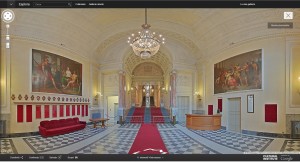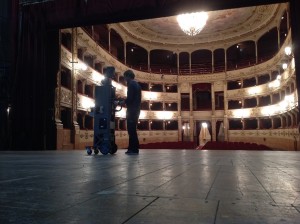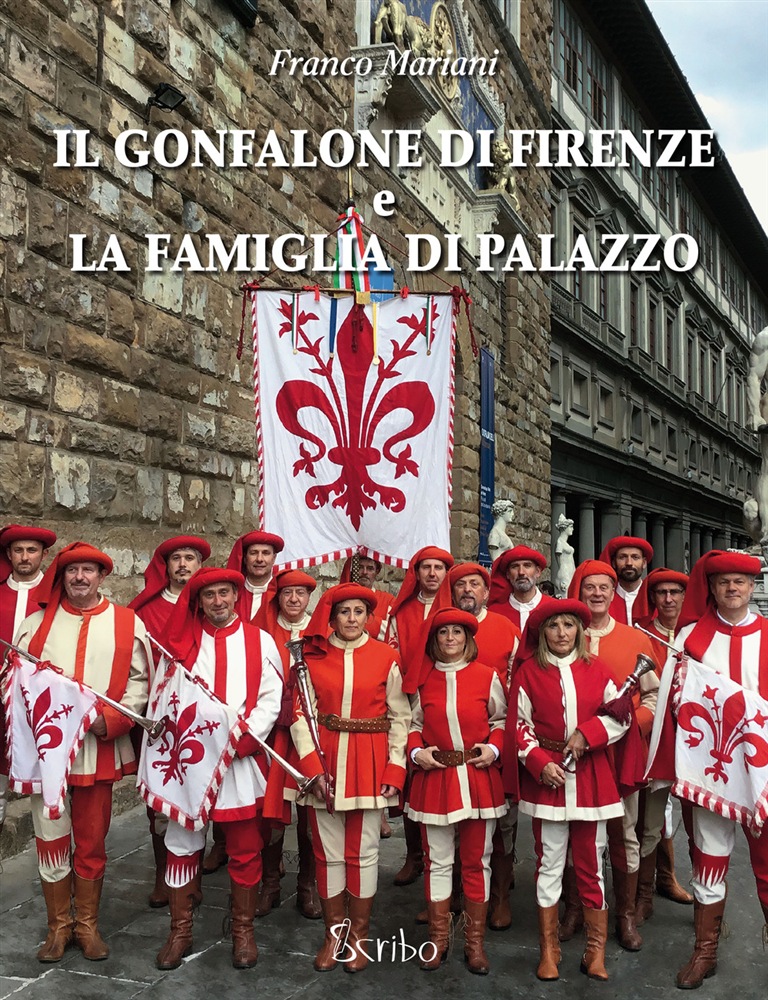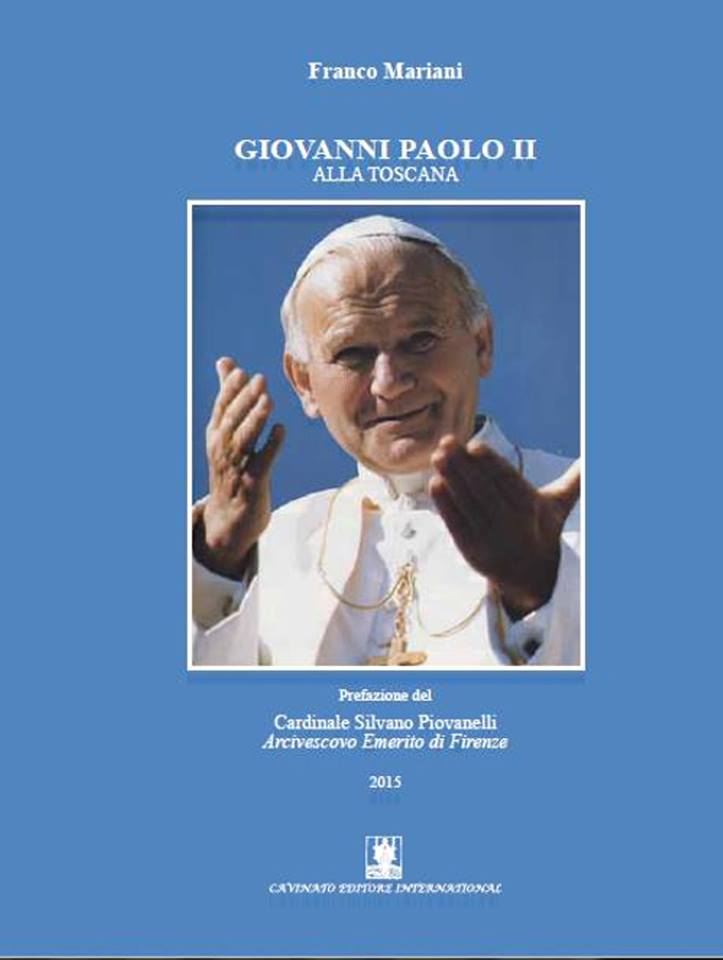Teatro della Pergola on Google Cultural Institute
 The Teatro della Pergola is the first theater in Italy, third overall after the Paris Opera and the National Theatre in London, to join the Google Cultural Institute, the platform developed by Google to make accessible on the Net the artistic heritage of the most important cultural institutions in the world.
The Teatro della Pergola is the first theater in Italy, third overall after the Paris Opera and the National Theatre in London, to join the Google Cultural Institute, the platform developed by Google to make accessible on the Net the artistic heritage of the most important cultural institutions in the world.
By connecting to www.google.com/culturalinstitute/collection/teatro-della-pergola you can visit the interior of the theater with Street View in Google maps and see the exhibition permanent digital Eduardo De Filippo at the Teatro della Pergola, which tells, through valuable documents such as manuscripts, Lettere autographs, photographs and historical videos, the path between the memories of Eduardo collected at the Pergola in the years between 1940 and the 1984.
Leveraging technology of Google Street View through a device dubbed 'Trolley', in gathering the images and transfer them to Google Maps, was made a photographic mapping in high definition of the interior of the theater.
From today it will be possible to make, anywhere in the world, a virtual tour of the oldest Italian, viewing paths and works with an extraordinary detail.
It will closely observe the decorations of the time of the inputs and the ceiling, will enter the Great Hall and go beyond the curtain painted in history 1828 of Gasparo Martellini, walk behind the scenes on the stage, linger in front of the 'phone noise' of Antonio Meucci and enter the First Camerino Eleonora Duse and in the basement.
In Italy the 'Trolley' was opened in 2001 for the mapping of the interior of the Uffizi, as part of the first edition of the Google Art Project. Until now it has been used in over 150 places in Italy and in the world, including the Capitoline Museums, the Space Science Museum in Japan, the White House and huts in Antarctica as Shackleton's Hut and Scott's Hut.
Eduardo, like all great men of the theater, had several city election: his native Naples, Rome that saw him make his debut at the Teatro Valle and baby Florence where his "home" was the Teatro della Pergola.
A special report, made replica memorable, celebrated debuts and the dream of a School of Drama, through which pass on his knowledge to future generations.
A special report enriched and strengthened by the particular tune with Alfonso Spadoni, then director of the Theatre.
Thirty years after his death, Eduardo De Filippo at the Teatro della Pergola (1940-1984) retraces, through high-resolution images of posters, handwritten documents and unpublished, Photo e video, a history of success and tradition that goes from 1940 al 1984 and that captures a great man of the theater in its true home: Theatre.
Launched in 2010, the Google Cultural Institute is responsible for developing technology with the aim of promoting and preserving the culture online. All projects of the Google Cultural Institute are the result of tight collaboration with important Italian and international partners: museums, foundations, cultural sites, archives and other institutions that manage the content they own within the technological platforms provided by Google.
Among the most recent projects by the Google Cultural Institute is the creation of an archive of shows Digital. From the fruitful collaboration with the Nelson Mandela Foundation and the Archive Yad Vashem, which made accessible thousands of documents, was reached in October 2012 to launch 42 online exhibitions that tell some of the historical events that have marked the twentieth century from different points of view. These include the Holocaust, l'Apartheid, the end of the Iron Curtain and the period of the Dolce Vita, which characterized Italy between the 50s and 60s. Again, this would not have been possible without the collaboration with the cultural institutions that have joined the project, first of all, in Italy, Institute LuceCinecittà.
The over 700 exhibitions currently available on the website of the Google Cultural Institute are just the beginning of a journey that will go forward in time, deepening new themes, subjects and historical reference periods.
Through these exhibitions, the Google Cultural Institute aims to increase the number of cultural information available online, in line with the very mission of Google.
Starting from the digital displays, or directly from Google Maps, once you cross the threshold of the main entrance, Virtual visitors can cross all places of Theatre and linger, with a sharp 360 °, on some of the works that tell the history and prestige in the world.
In the entrance hall there are two neoclassical paintings: Death of Lucretia by Giuseppe Collignon, depicting a symbol of women's history of ancient Rome, model of moral integrity, and Ettore scolding Paris for its softness, where Pietro Benvenuti, to inspire solemnity and grandeur ethics, gives images and colors to VI Iliad in which Ettore, prince and hero of the Trojans, urges the brother Paris to return to fight at his side, Instead of lounging by the beautiful Helen.
Going wide stone staircase leads to the foyer, the Atrium of Columns, and from here in the Great Hall, that opens the eyes digital oldest Italian theater stages in overlapping.
The eyes may run up to the ceiling, decorations by Michele Garinei, representing Glorification of Art lyrical and poetic. From the mouth of the opera art music, enthroned at the center of the composition, is surrounded by musical figures. It inspires the various manifestations: the Gagliardia, which holds aloft, with the right, a bouquet d'Olive, with the result, around which fly bee; the Joy, depicted in a group of two putti one of which supports its emblem consisting of the cup and the cup of gold; Pain, Breast bleeding, pierced by a snake rodent.
On the opposite side, Poetry, center, cinta laurel, has the right to its elegance that maintains a mirror, to his left the Fantasia with his head and arms winged, with the right hand a scepter surmounted by an eye. This inspires Eloquence portrayed in Mercury. The Philosophical Thought, symbolized by an old man in the act of meditation, and the Glory, supporting a garland, complete the virtues which together all'Ardire, depicted as a strong man in the act of pluck with an iron tongue of a lion, combine to produce the Abundance and Gaiezza, symbolized by two figures that support one a bundle of wheat, the other flowers.
The sides closer ceiling are two groups of putti alluding to the two arts that complement each other and serve connecting the two compositions.
The stage curtain is closed from Historical, painted by Gasparo Martellini (painter of the school of the aforementioned Welcome) and depicting the coronation of Petrarch in the Capitol. Commissioned by the Academy of Real Estate, the Florentine artist conceived a complex allegory of great solemnity narrative. A winding parade winds through classical buildings in the center and has a majestic structure: a triumphal chariot, whose seat is sitting Petrarca; around players, famous men and, from le figure allegoriche, Patience, virtues necessary to the Poet. The Historical curtain opened for the reopening of the theater in 1828 and is used today, thanks to the restoration of 2008 which has integrated gaps, correct additions from previous restorations and restored handling.
Thanks to the technology of Google Street View, visitors can cross the digital curtain Historical and access to areas normally closed to the eyes of the common viewers: behind the scenes of the theater.
Here you can stop on the 'phone noise' of Antonio Meucci. Thirty years of the nineteenth century, the torpid Florence the last Lorraine. The Teatro della Pergola is the preferred stage opera, the place of election of composers such as Gaetano Donizetti. Sits at the helm of Alessandro Lanari, the "Napoleon of the businessmen", the man who came from San Marcello di Jesi. The stage is all a quiver of activity, machinists, toolmakers, scenography, Helpers, extras working on the construction of the "wonderful show", melodrama. Antonio Meucci lands to the Pergola as a machinist and 1833 al 1835 leaves his mark on the ingenious system of voice communication between the stage and balconies: is the ancestor of the phone, Meucci who perfected later, ingeniously, but no luck, once emigrated to the United States.
The theater, art from poor memory, relives through everyday objects, and tells viewers today the silent history of those who have gone before them. In December 1906 arrives at Pergola Eleonora Duse, Divine, with legendary Rosmersholm Ibsen directed by Edward Gordon Craig: A plaque that Prime Camerino Theatre next to the stage was built for her and still continues to be inhabited, night after night, from all the major players in the Italian and International Theatre.
Back in the foyer you can climb to the Gold Room, where stands the coat of arms of the Academy of Real Estate, the group of Florentine nobles who founded and built the theater between 1652 and the 1656. A large mill bears the motto "In his movenza is stopped", because their actions were "moved by the firmness of virtue". The paintings of the vault, commissioned by the Academic Michele Garinei in 1912, depicting five of the nine muses of the arts: Polimnia, l'ode, dressed in white holding a book with the word 'persuade', Terpsichore, Dance, with zither, plectrum and lyre, Melpomene, Tragedy, with stiletto and scepter, Euterpe, lyric poetry, with a flute, Such, comedy, with a mask boundary ivy. In Saloncino, instead, are depicted, at the center of the bottom wall, Apollo with lyre, and sides, in two separate panels, of putti, holding musical instruments of the heroic times, gait towards the god of all arts.
Michael Lattanzi
By the number 44 – The Year of 17/12/2014








Follow Us!